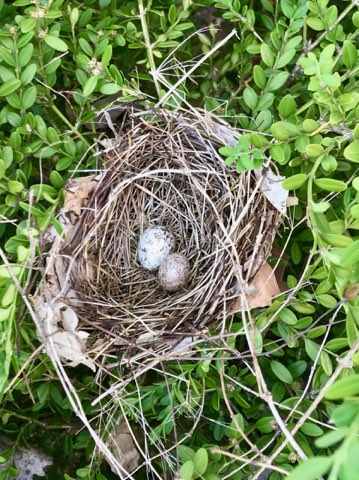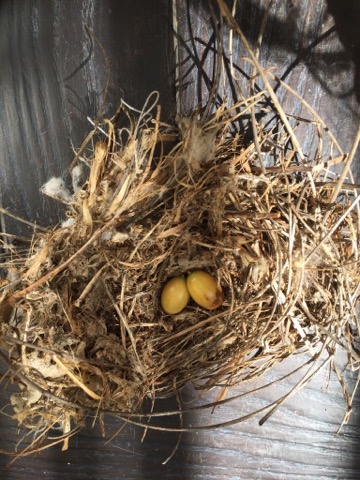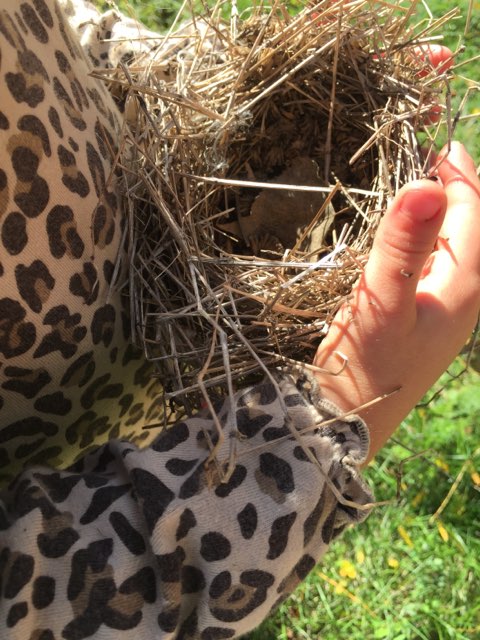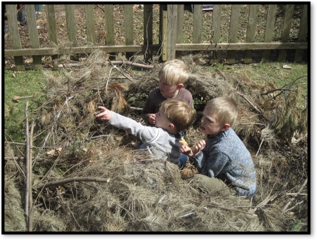Nest Building is STEM Building
“I found an empty nest! Can we keep it?” Owen’s joyful discovery captures everyone’s attention.
Three-year-old Avery comes running. “Are there eggs?” she asks her older and wiser five-year-old friend. “Can I see?” she begs. “Please let me see?”
“There are no eggs, just an old nest. Can we please keep it?” pleads Owen.
After a quick glance to confirm that the nest cradled in Owen’s hands is not harboring a feathered inhabitant, I grant my permission.

Owen handles the nest gingerly before realizing that it is sturdier than it looks. After a few tugs and a few moments of studying the nest, he very gently hands it over to the others.
We have a collection of nests. We love to study the materials used to build each nest, as well as the nest construction methods used by different local bird species.
We also try to guess the type of bird that built each nest and how many eggs might have been laid in these cozy homes crafted from sticks, grass, leaves, string, mud and other found objects.


I watch Ave silently investigating and collecting data as she turns the nest in one direction and then another. You can almost see the wheels turning.
“I think the bird used some litter [drinking straws, food wrappers and other debris] to build this nest.” Ave giggles. “And there are like a million sticks in here!”
“A million?” I echo.
“Maybe more!” Ave theorizes.
This moment gives me a valuable insight into Ave’s nascent number sense. Connecting numbers to quantities is a skill that will continue to emerge and evolve with age and brain development.
“The bird added string—and look at this piece of wire she wove in!” shares Maya. “It’s lightweight but very strong. How long does it take her to make this nest? I think this nest is smaller than the others we have.”
This is how we set our curriculum for the day—by following the interests of the children. When we return to our indoor classroom, we will dig out our books to learn more about the various engineering practices that local birds use to build their homes and compare this newest nest to the others in our collection.

Living along the Mississippi River as we do, we are blessed with the return of our beloved bald eagles each winter and spring. From December to March, these magnificent birds migrate south from Canada and often make our area their winter home. Some even like it so much that they make it their permanent home.
In the fall and winter, the eagles rebuild their nests to prepare for the hatching of the eaglets. Eagles nesting in our area typically lay their eggs in mid-to-late February, and the eggs hatch by mid-to-late March.

Once the eggs have hatched, the female stays with the eaglets while the male leaves to find food for the female and her hatchlings.
The eaglets grow quickly and are ready to fly—or “fledge”—by late May or early June. A number of webcams have been set up by organizations in the area so that we can watch the life cycle of the eagles playing out before our eyes.
This is where I struggle. We are a screen-free environment. I know that we can link to so much learning with technology. I know that I need to stop being so stubborn. I am that old-school playground leader who hasn’t embraced the many educational benefits of 21st-century technologies.
We weren’t always screen-free—and I have fond memories of the year when we observed a wee bit of eagle life via webcam.
I hated the screen, but I loved learning about our local eagles. When an eagle brought a large fish to the nest, we were spellbound. But the fact that we’d been sucked into spending time staring at a screen contradicted everything that I believed in regarding early education—and I was overcome with guilt.
So when the first warm day of spring arrived, we created our own eagle’s nest in the center’s outdoor play area.
“Declan, how big is an eagle’s nest?” I asked, measuring tape in hand.
“Seven feet wide,” he responded. “What are you doing?”
I quickly measured out seven feet and put a heavy rock from the rain garden on the spot. The children began adding rocks until we had a circle that was seven feet in diameter.
For a few minutes, the children pretended to be eagles living in a happy little rock nest—until one perspicacious preschooler called me out.
“Wait! This isn’t a nest!” Asa declared. “We need to add sticks and leaves and yarn. We need more!”
“We do need branches and sticks!” agreed four-year-old Joshua.
“Over here!” directed two-year-old Gabe.
Game on! Now we were learning, creating and analyzing. We’d taken what we’d learned during our screen time and translated it into real-life, hands-on learning that met so many of the math and science standards that they would struggled to achieve on a worksheet!

This was when we grabbed our books and discovered that an eagle has a wingspan of 6-8 feet. We also learned that a mature eagle has 7,000 feathers, weighs 8-11 pounds and has vision so keen that it can see the print on a newspaper at a distance equal to the length of a football field. These are the details that young children are likely to absorb.
Because bald eagles are most active from sunrise to 11 a.m. as they feed along the open water of our locks and dams, this coincides quite well with our outdoor times. Lucky for us, they return to their roosting areas in the afternoon hours.
 After lunch, some time spent browsing through eagle books and a nap, the boys made their way back out to their new eagle’s nest. If they build it, they will play in it. They had been playing there for a good long time when, sure enough, up in the sky, an eagle appeared!
After lunch, some time spent browsing through eagle books and a nap, the boys made their way back out to their new eagle’s nest. If they build it, they will play in it. They had been playing there for a good long time when, sure enough, up in the sky, an eagle appeared!
Yes, a real live eagle! Would she think this was HER nest? Could she see the boys in HER nest?
As the boys contemplated the possibility of the eagle swooping down and landing amongst them, they scrambled out of their nest in pure terror.
The eagle did not land in our nest. But, sadly, our frightened little learners never returned. I left the nest in place for over a week, and some of the younger children played in it, but the boys who built it kept their distance!
I often find that most of the fun is in the building phase of the project. The collaborating, creating, adding, subtracting, analyzing and evaluating with friends is actually the play for building kids. This is the good stuff that happens with play; enough time to engage in deep, investigative learning; and, sometimes, just the right amount of technology.

Take time to follow the lead of your students and see where their interests and curiosity take you. Then match their learning up with your early learning standards.
This link will take you to the Arconic Eagle Cam.
Full disclosure: The male eagle will bring food back to the nest. This could be a raccoon, a fish or a mouse. It is nature. It is graphic. It can be addicting or terribly uneventful at any given moment!
When we build nests of our own, we often use this Scientific American site as a reference. But if you’ve lingered too long on the Arconic Eagle Cam link provided above and feel guilty about overdoing the screen time, you can just WING it—pun intended!
Ha! Let’s get outside and play.
Collecting the data of how the nest is made and guessing what kind of birds laid the eggs is a great idea.
This could be a great observational activity for all ages. The Teacher could describe how the bird built the next with various materials, by weaving them into the structure, inside, on top, around.
I’m a firm believer to teach what children are interested in and love the idea of the children making their own big nest
I love this activity it is a great way to teach children about the things they like and making learning fun.
This activity looks like so much fun. You taught the children about math in such a fun way. I love how big the children estimated the nest to be and were accurate.
What a fantastic way to naturally learn about science and math. To have access to eagles and nests is an amazing way to naturally engage children in these discussions. I love how you used the children’s curiosity and interests in nests to create your own playground eagle nest in exact proportions so that the children could ‘feel’ and see the exact size of the nest – 7 feet.